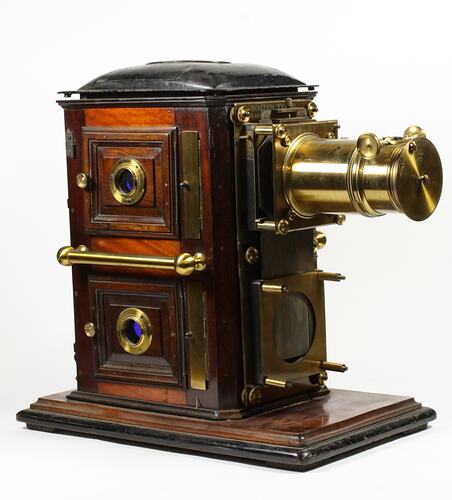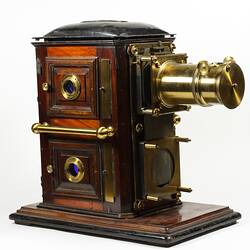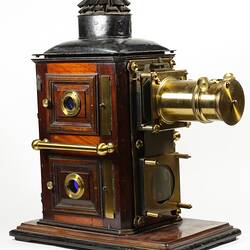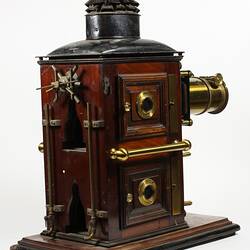Summary
Projector used to view lantern slides. It was manufactured by Walter Tyler. Tyler, who began as a lantern exhibitor, opened a shop in 115 Waterloo Road, London in 1885. This particular lantern dates after a move to 48 Waterloo Road in 1887. The business, Walter Tyler Ltd., became one of Britain's largest retailers of lanterns, slides and accessories. Walter Tyler died in 1909 but the company continued its operation.
It is believed that the biunial was first conceived by E.G. Wood who was partner with the London instrument makers Horne and Thornthwaite until he left in 1855, The biunial lantern is a system of projection where two lanterns are inbuilt, one on top of the other. This form of projection became possible once the more powerful limelight illuminants were used and quickly became popular. By 1888 it was recorded that over 60 models were being produced, presumable in Britain. The biunial allowed for special effects such as dissolving views to be created by adjusting the brightness of the illuminant in each system.
While the invention of the magic lantern is generally seen to be in the 17th century, its greatest popularity as an optical projector spans the late 18th century to the early decades of the 20th century. It was used both as a means of entertainment and education.
This lantern projector is part of the Francis Collection of pre-cinematic apparatus and ephemera, acquired by the Australian and Victorian Governments in 1975. David Francis was the curator of the National Film and Sound Archive of the British Film Institute as well as being a co-founder of the Museum of the Moving Image in London, which was operational between 1988 and 1999.
Physical Description
Biunial lantern with mahogany body and base. Japanned metal rectangular top with oval aperture for chimney. All detailing is in brass. Condensers are insitu for both top and bottom lanterns. Brass top projection tube with swivel cover for lens. Lower projection tube missing. Has removable brass plate which slides behind spring plate to cover front of lower condenser. This has a circular cutout at place of upper condenser. Horizontal brass rail handle each side of lantern body. Two square doors (upper and lower) each side of lantern body. Each door has a circular blue glass peep hole into lantern body which is framed in brass. No internal illumination components present. Brass fittings for gas illuminant fixed to top centre of outer back wall - six brass pipes with controls, three each lateral side. Single vertical pipe down each side of back wall. Each pipe has a horizontal bend and external screw thread finish at bottom.
More Information
-
Collection Names
-
Collecting Areas
-
Acquisition Information
Loan & Subsequent Donation from Australian Film Institute (AFI), Mr David Francis, by Nov 1990
-
Collector
Mr David Francis, London, Middlesex, England, Great Britain, 1990
-
Manufacturer
Mr Walter C. Tyler, London, England, Great Britain, circa 1890
-
Inscriptions
Etched into back stage plate: 'WALTER TYLER./48. WATERLOO ROAD. LONDON.' On circular white paper sticker on back outer wall: '204' Handwritten on circular red paper sticker on top outer projection tube: '204'
-
Classification
-
Category
-
Discipline
-
Type of item
-
Overall Dimensions
620 mm (Length), 335 mm (Width), 530 mm (Height)
-
References
Brown, E. (ed), 'Walter Tyler Obituary' in British Journal of Photography Almanac Annual Summary of Photographic Inventions and Events in Photographic History/1910 Accessed 29 Oct 2010 at [Link 1]
[Book] Robinson, David, et al. 2001. Encyclopaedia of the Magic Lantern., 2001, 39-40; 312 Pages
-
Keywords
Lantern Projectors, Magic Lanterns, Pre-Cinema Moving Images, Projectors




